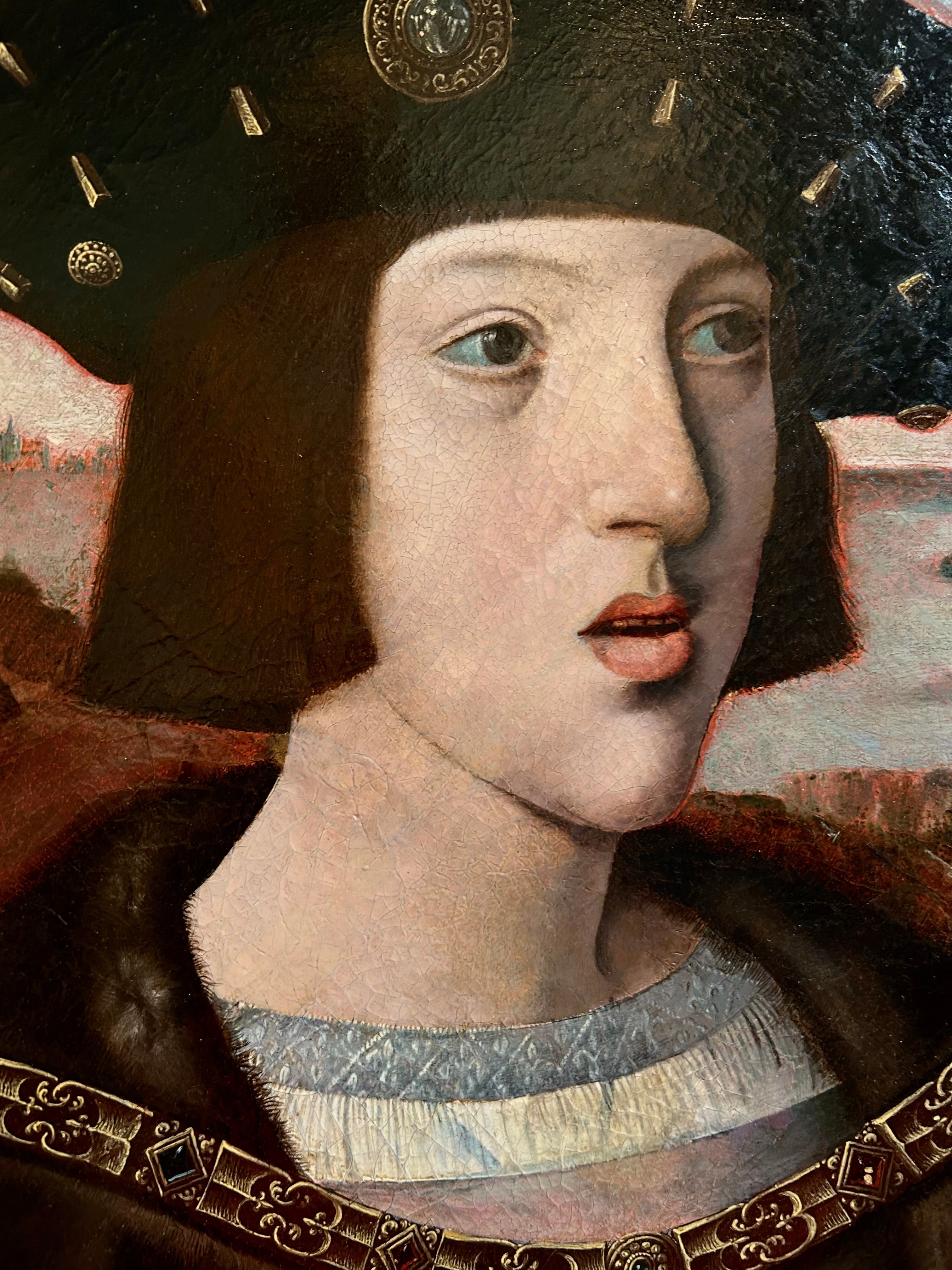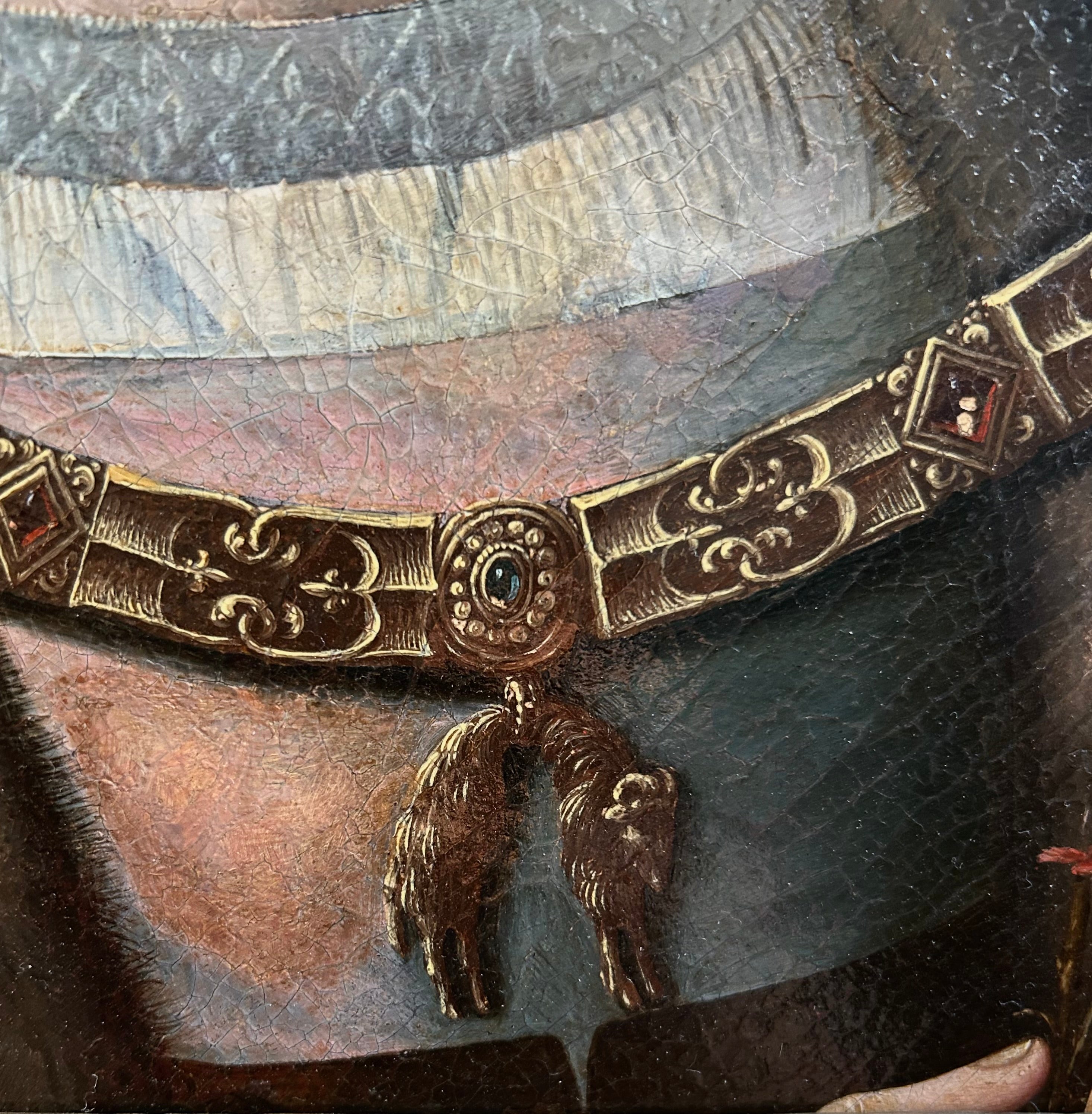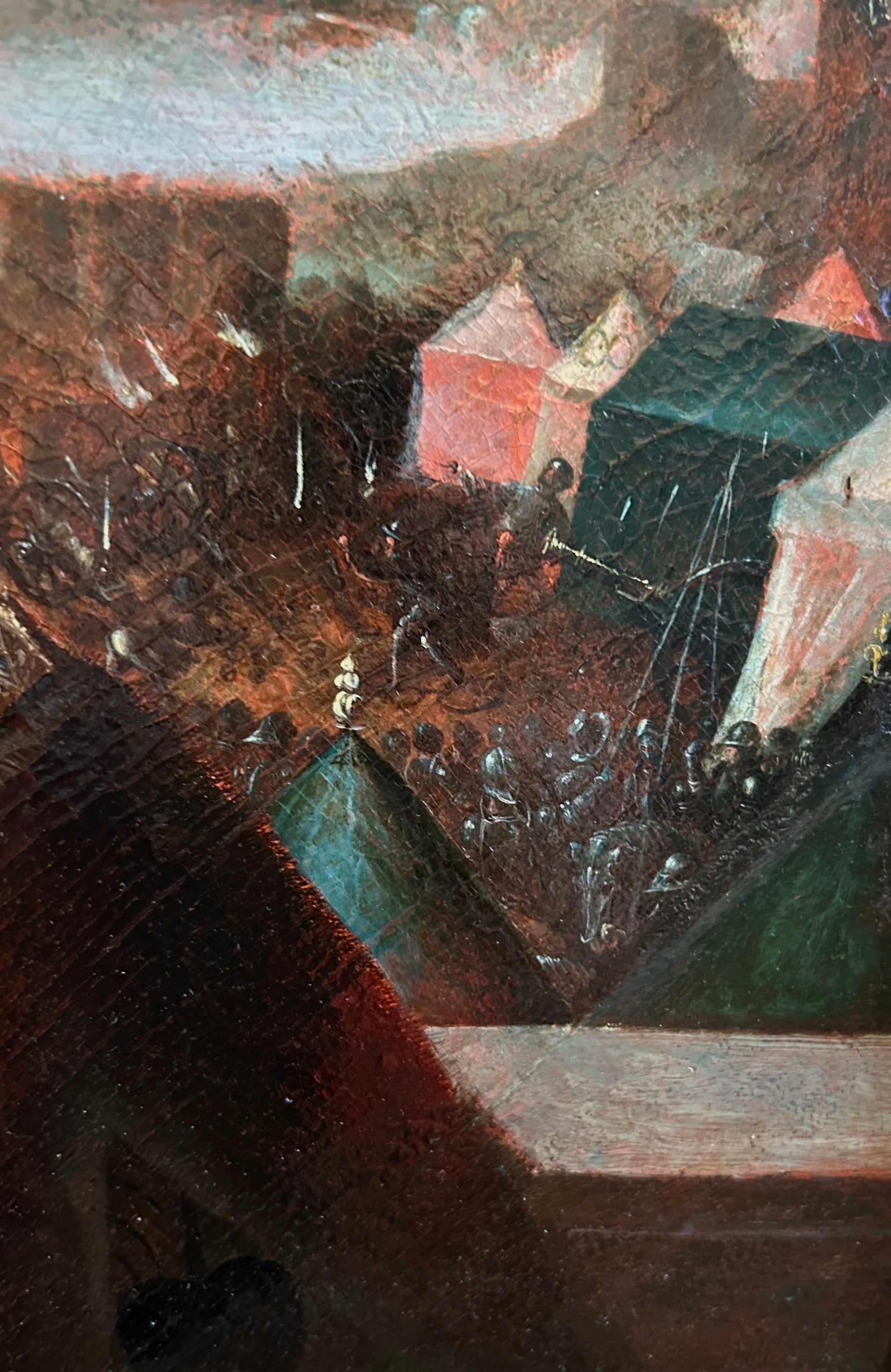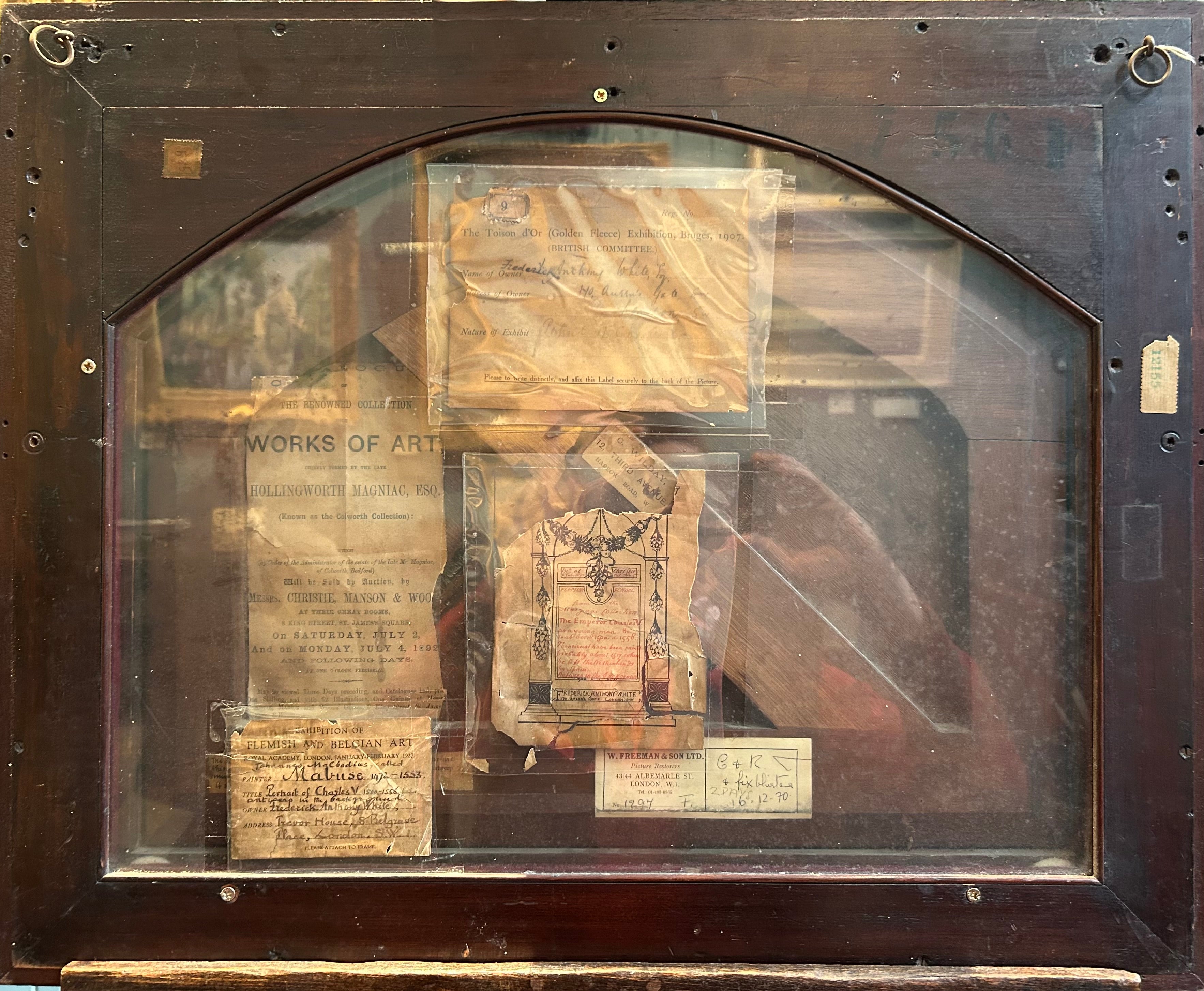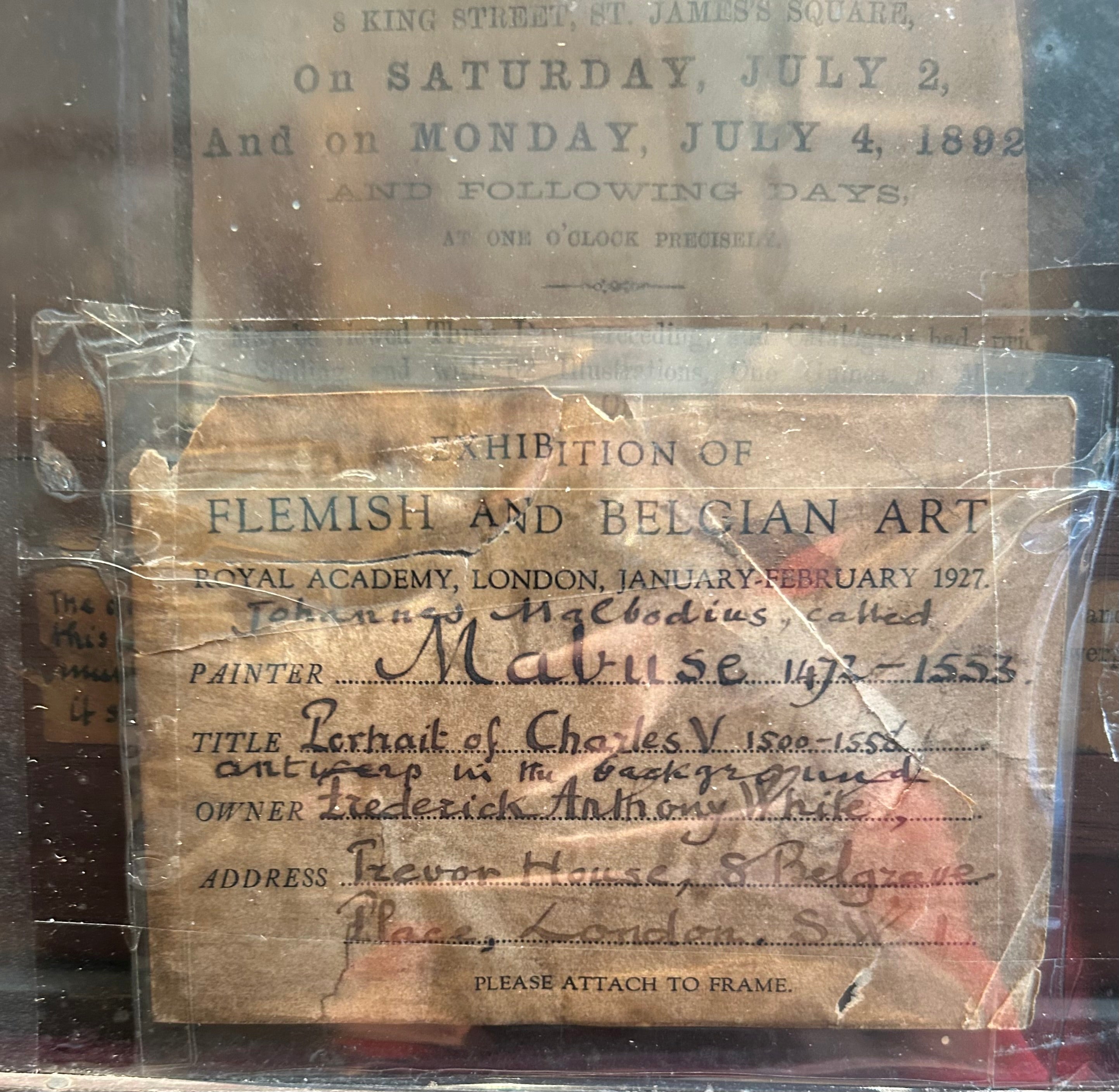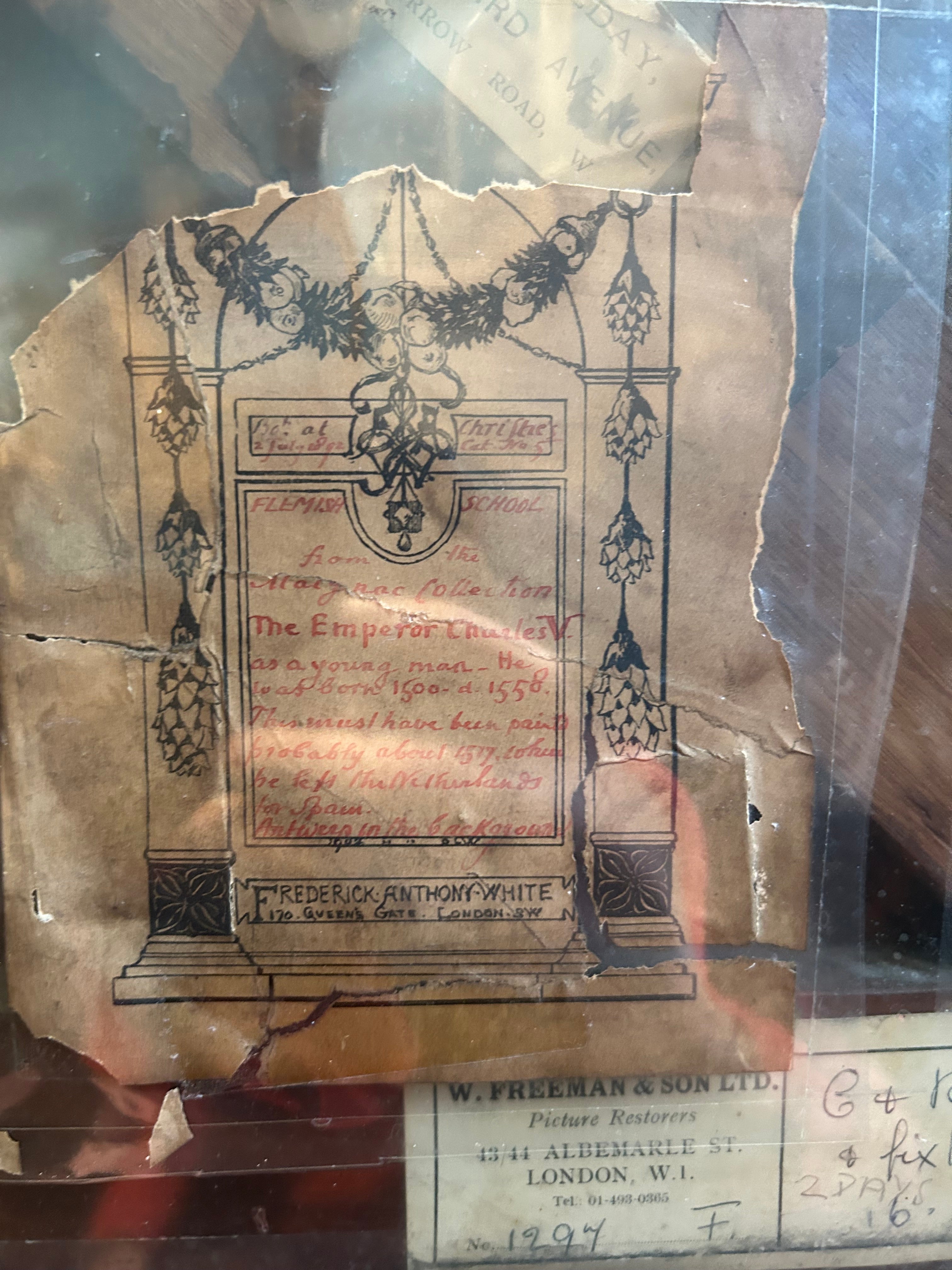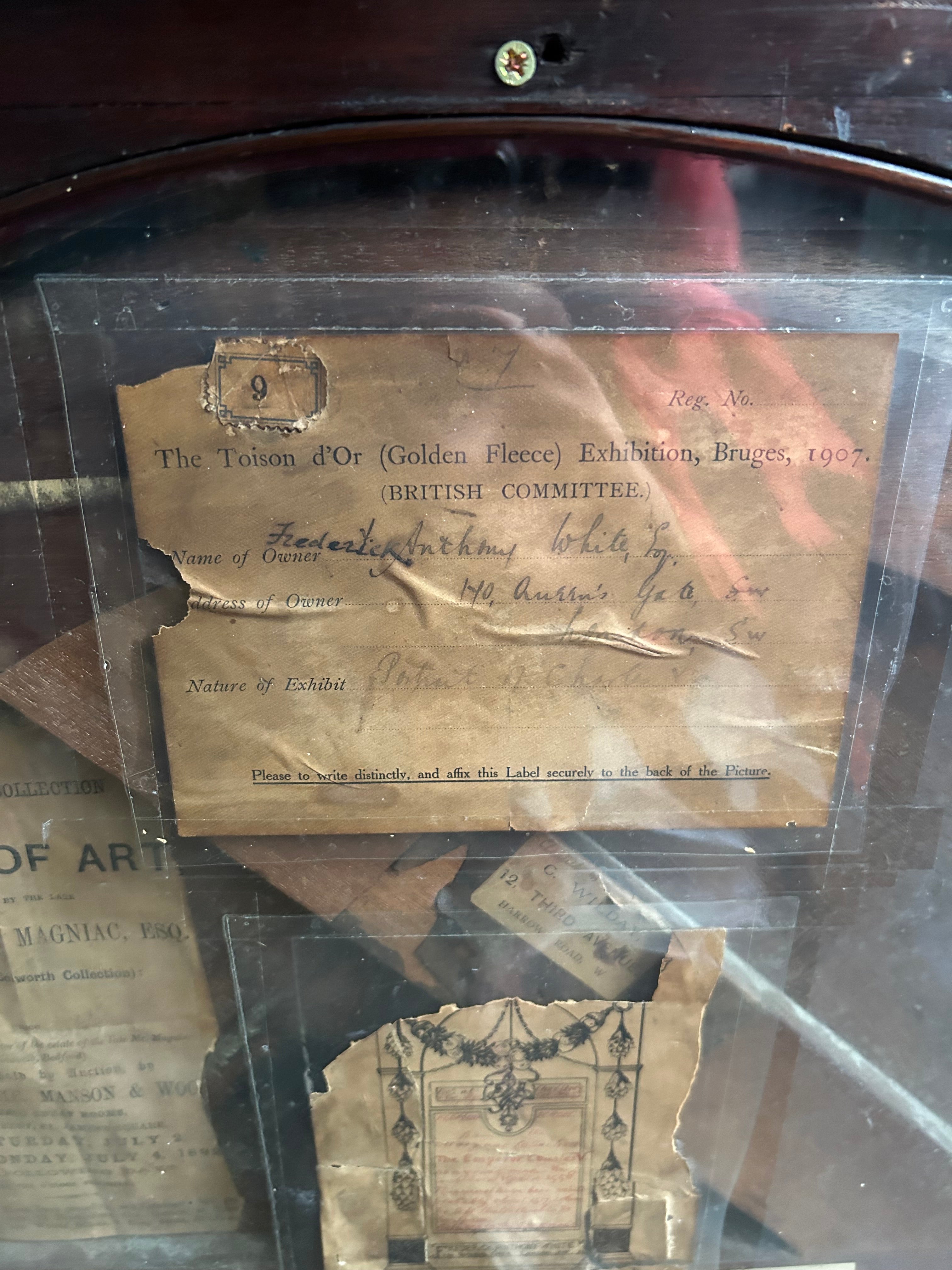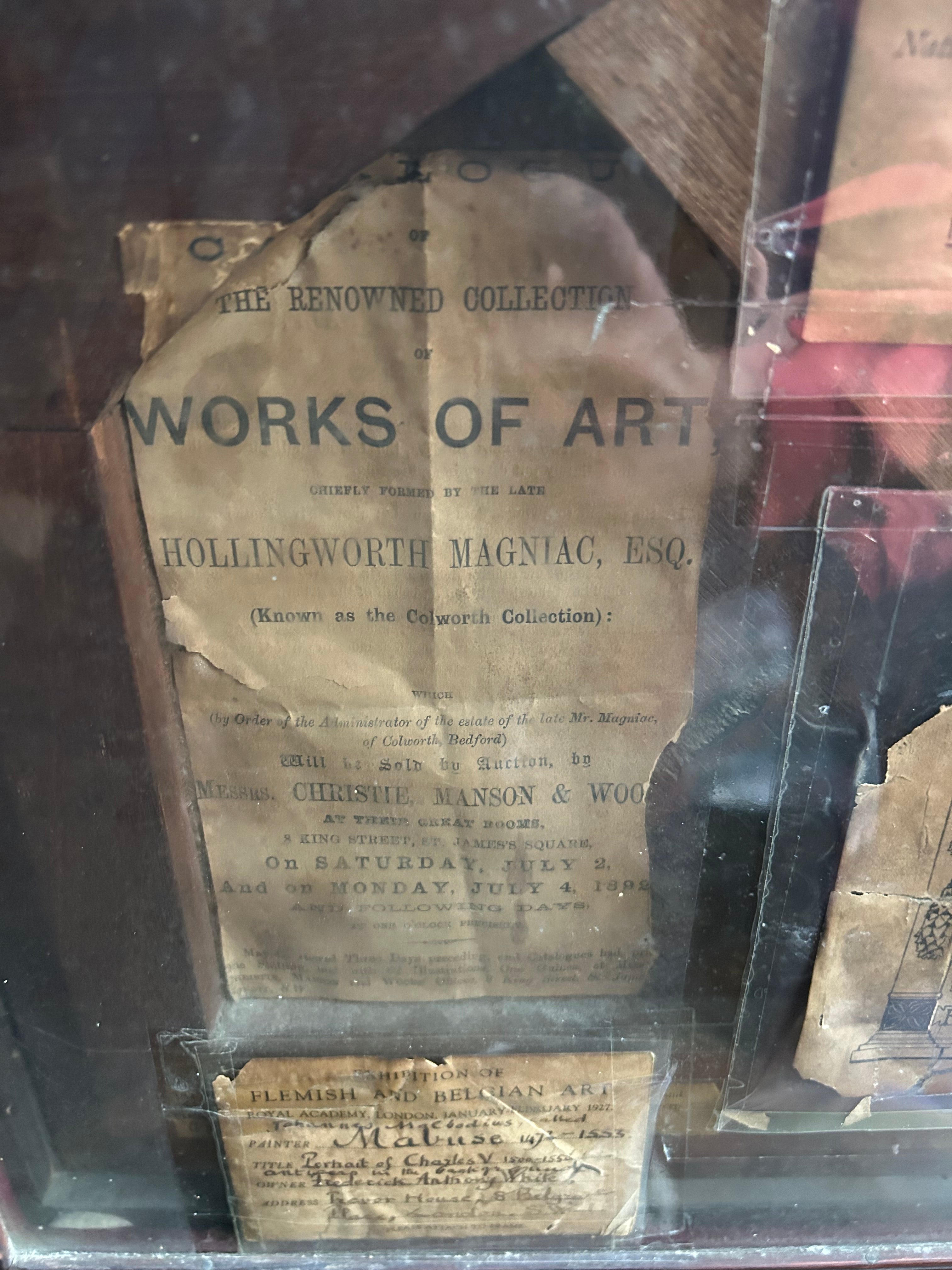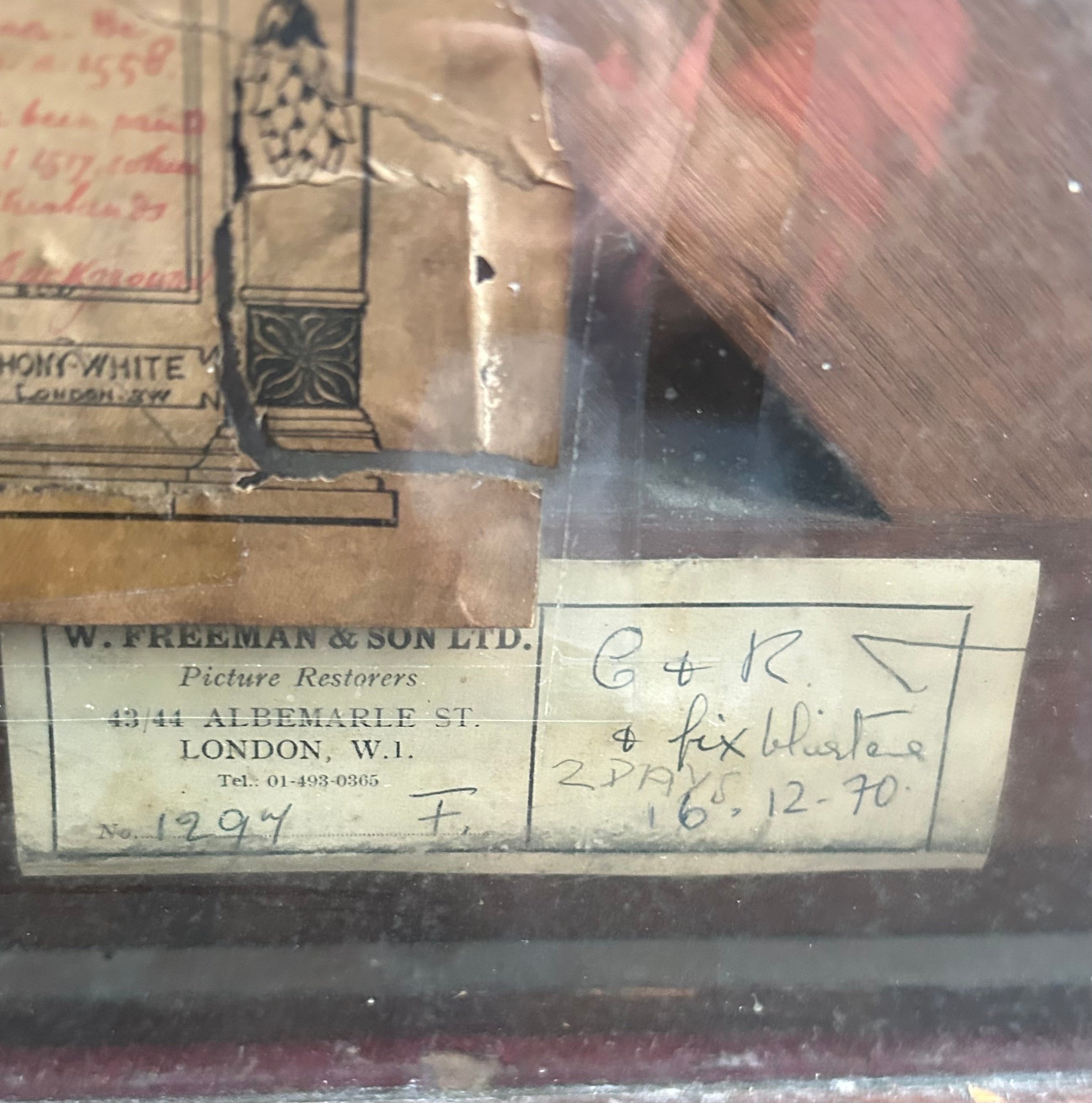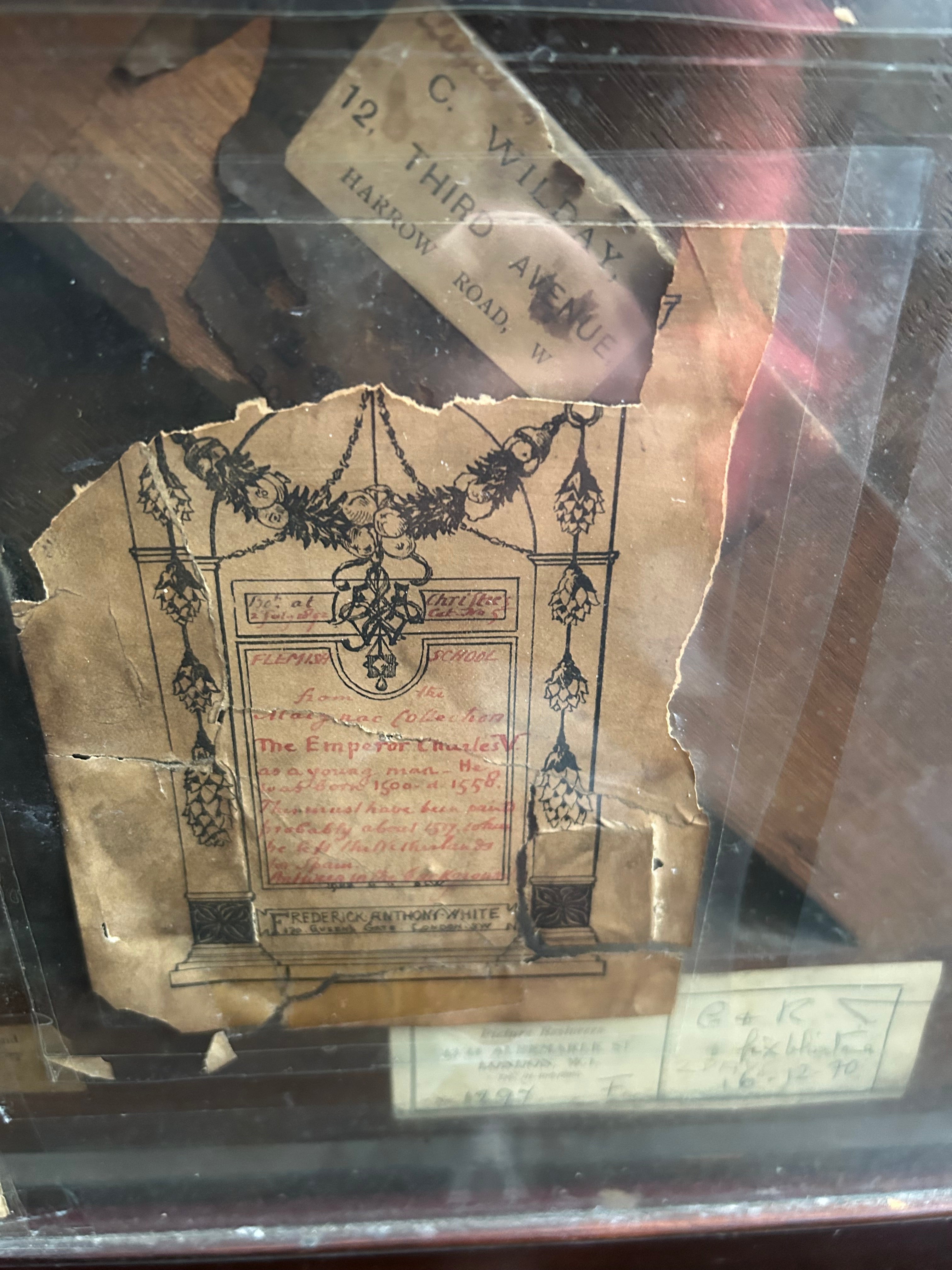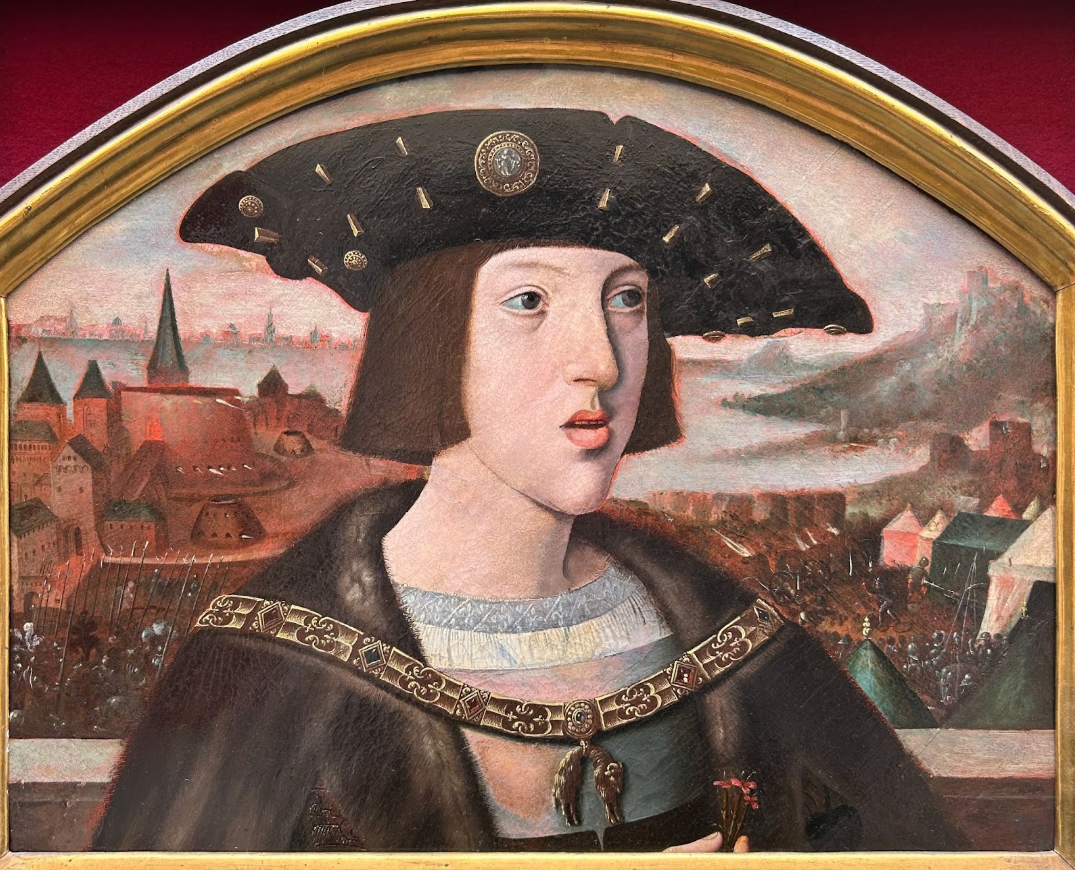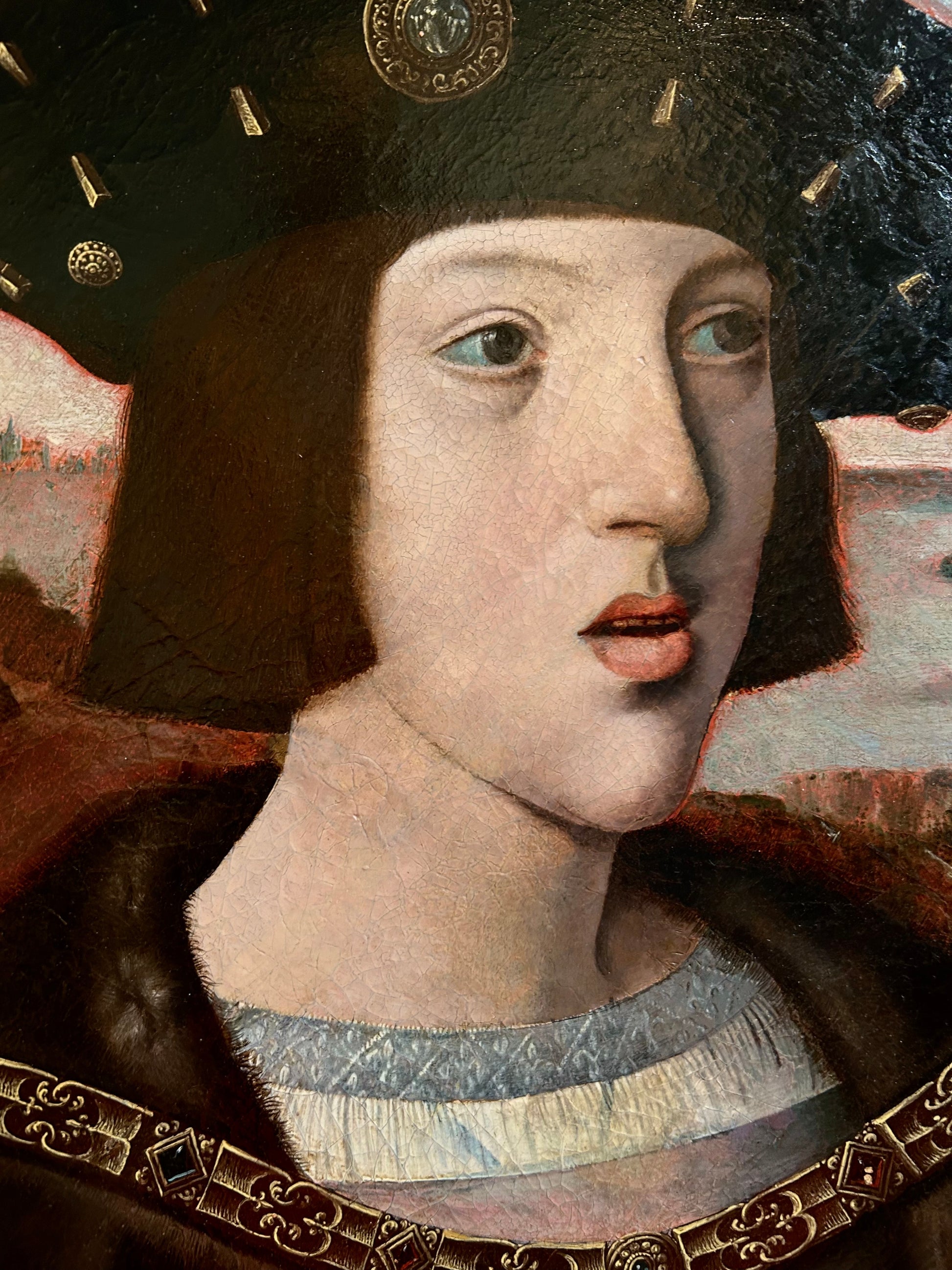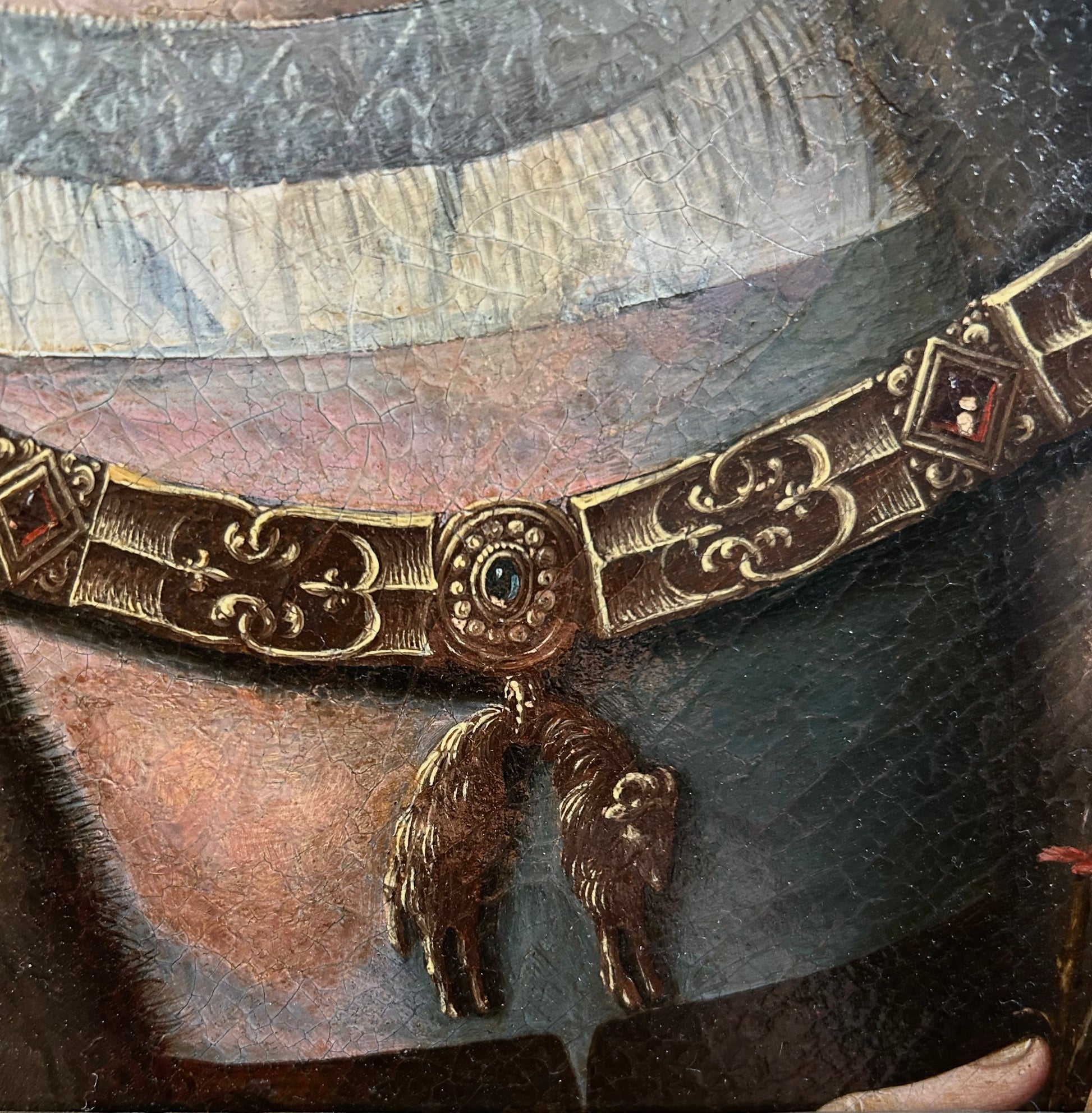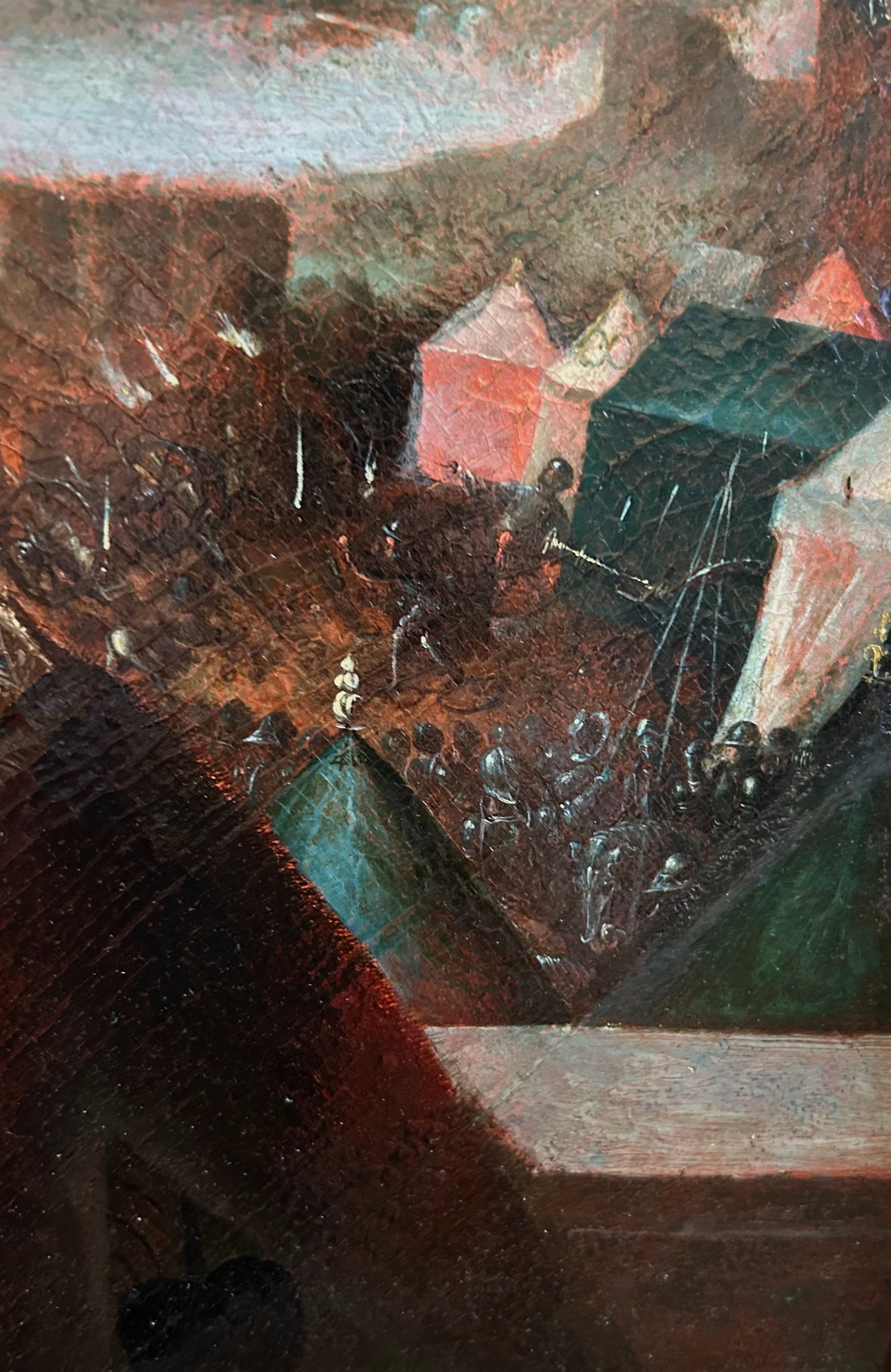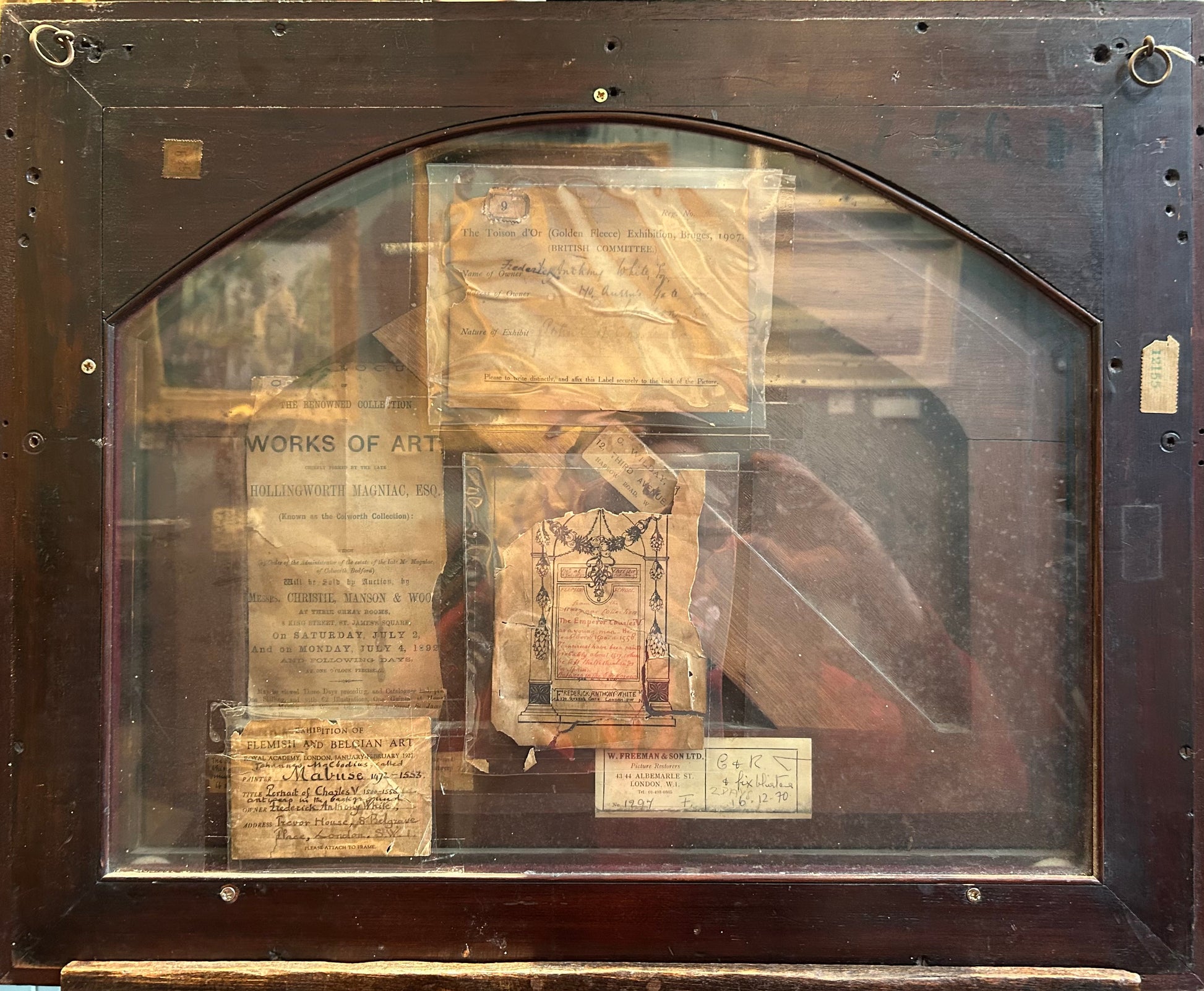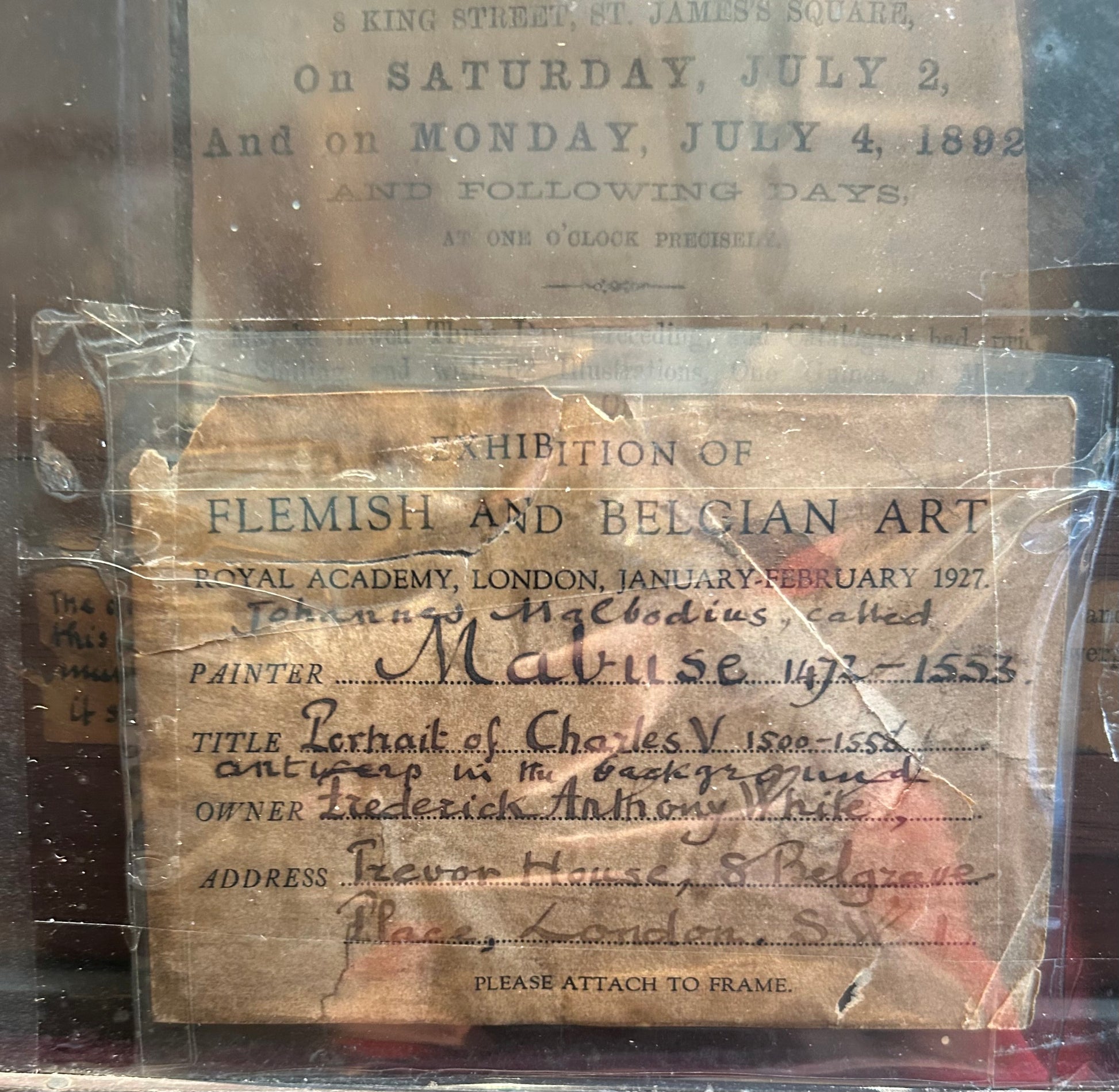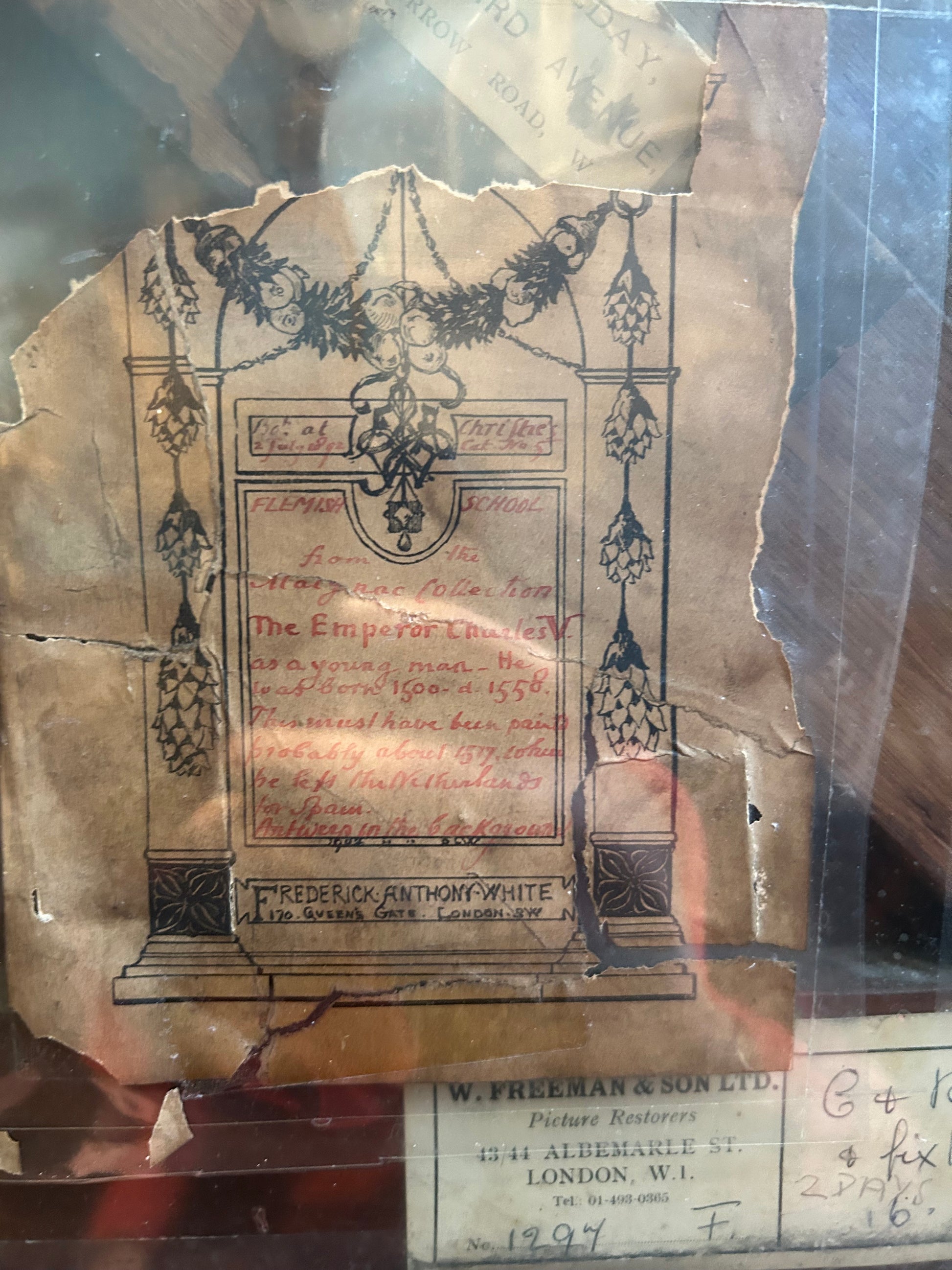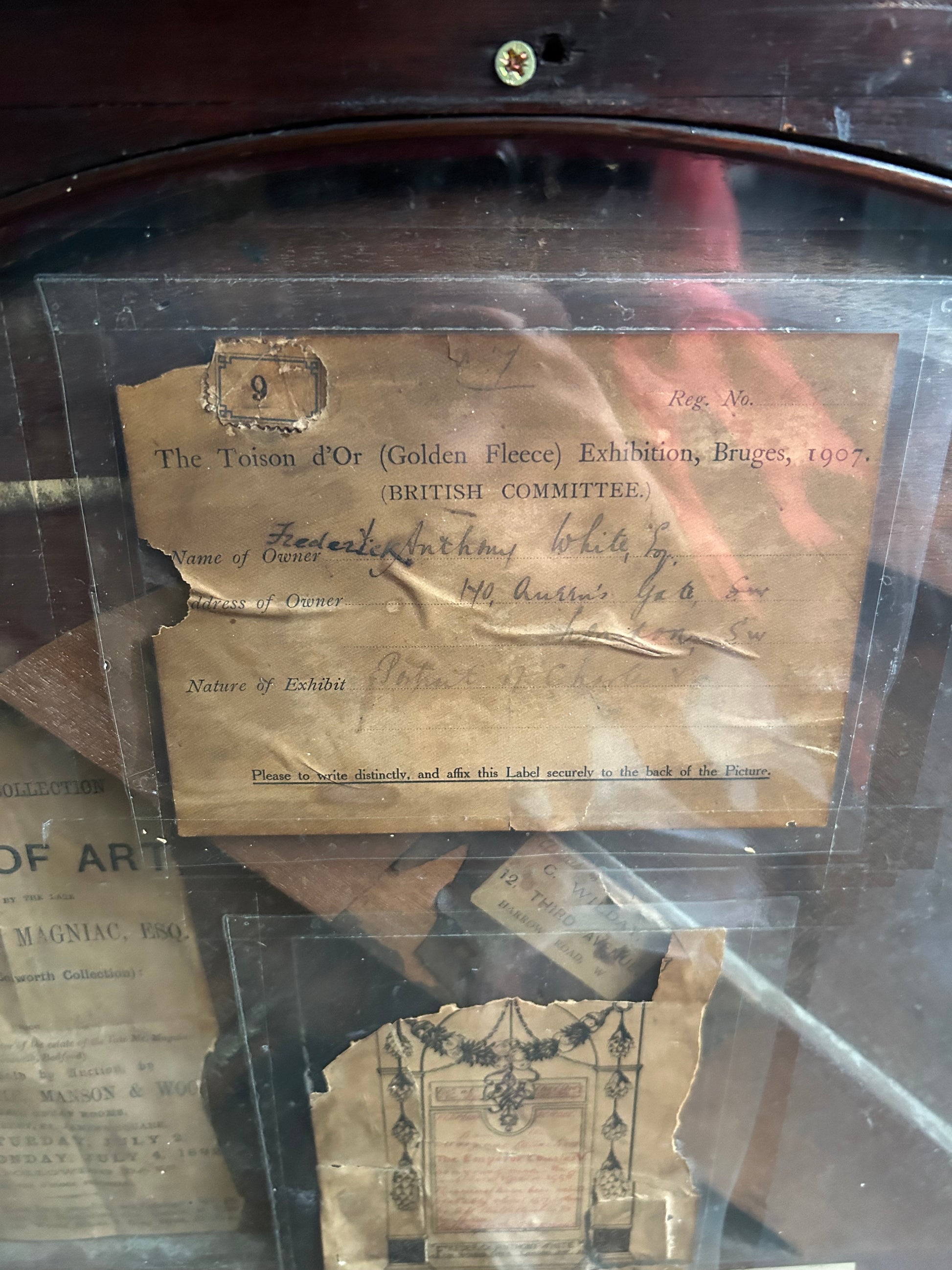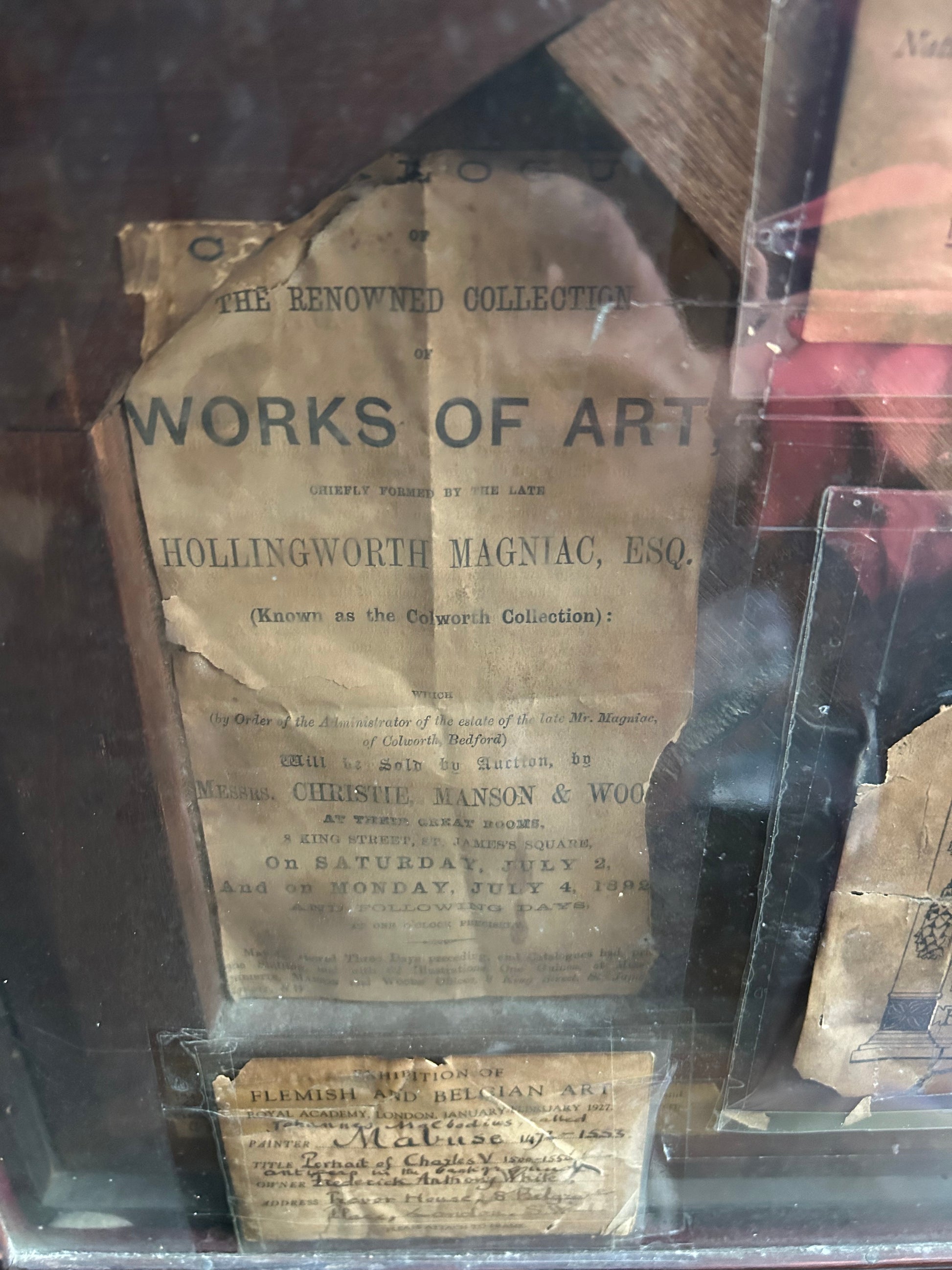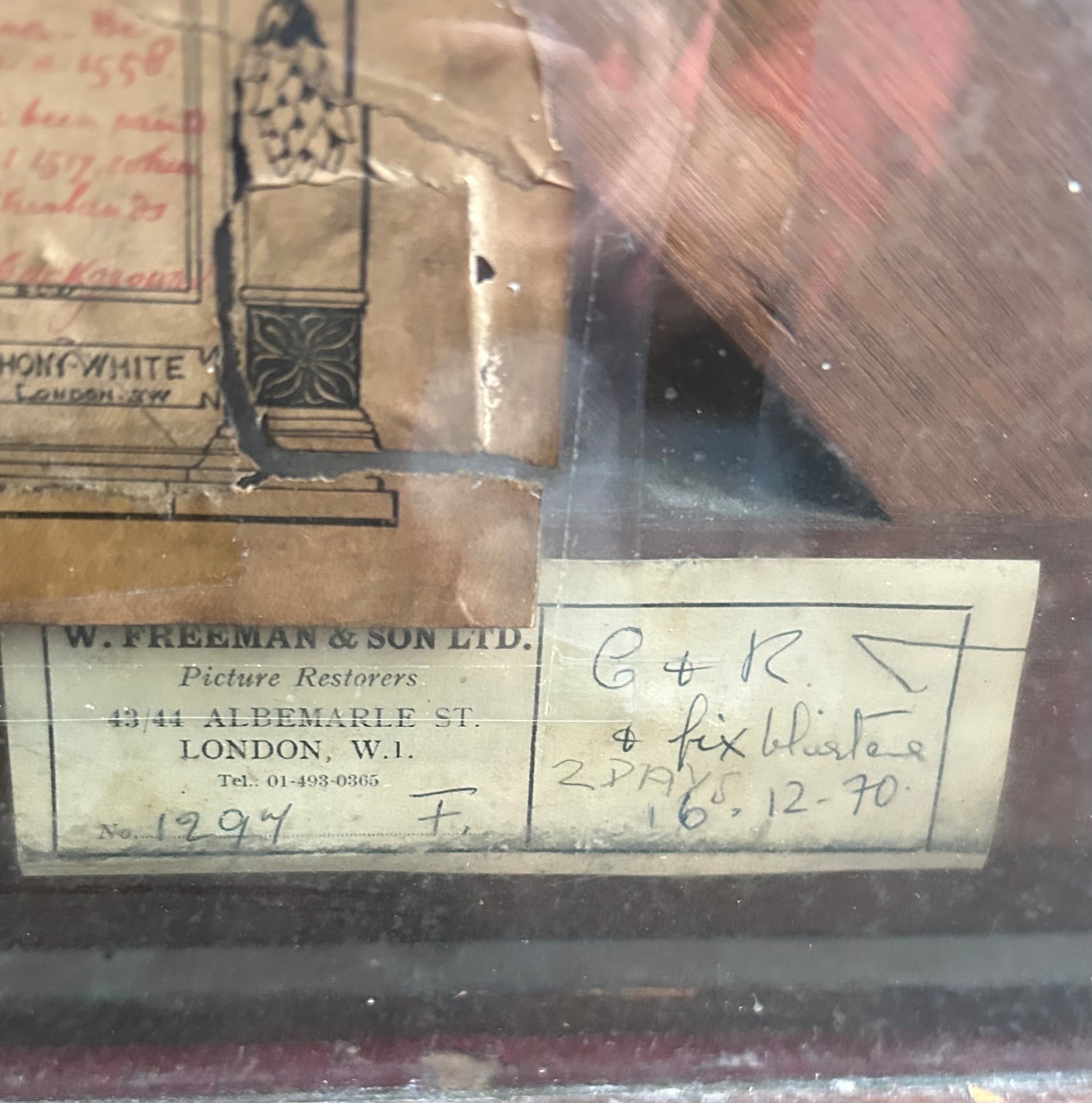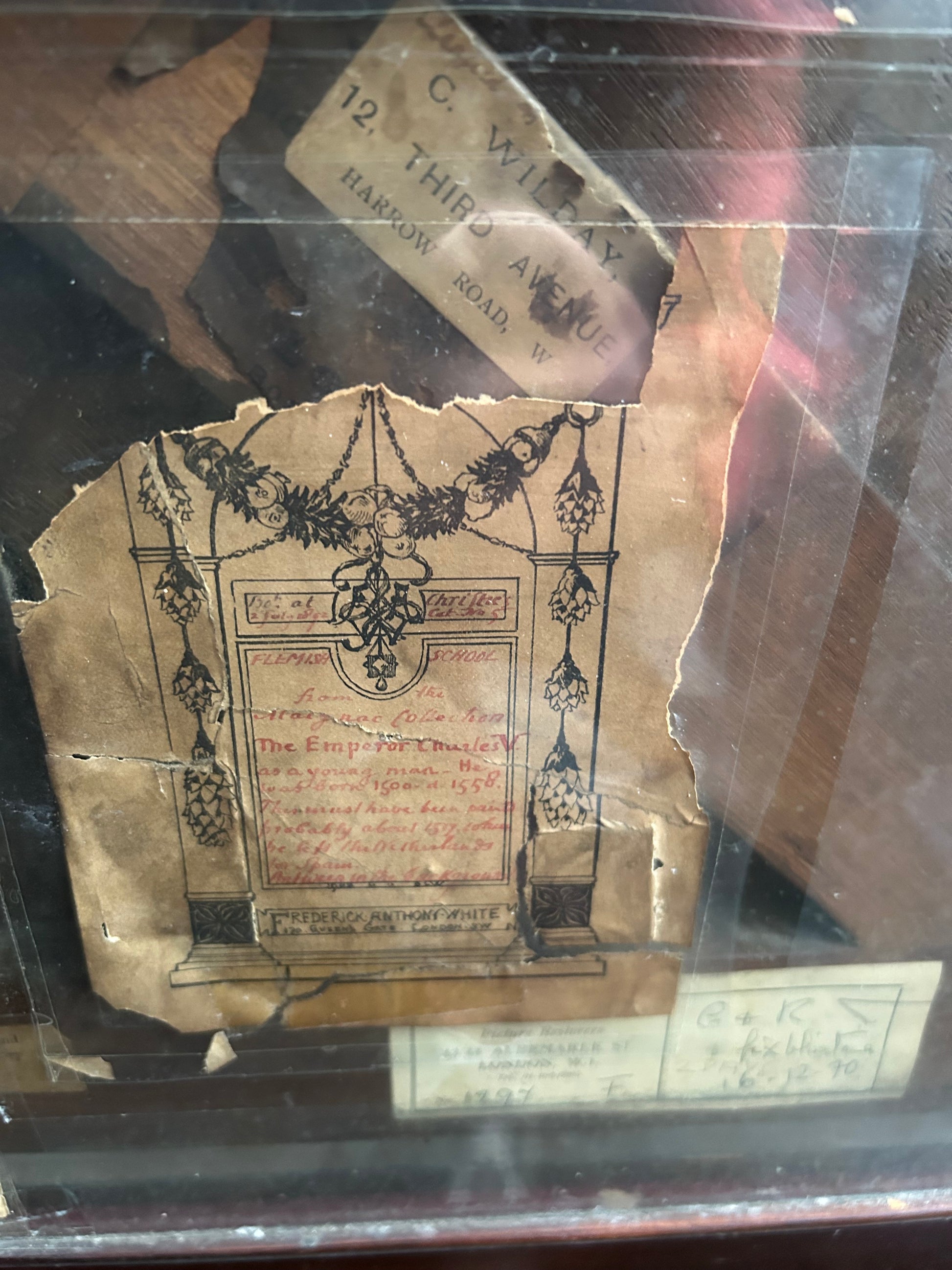
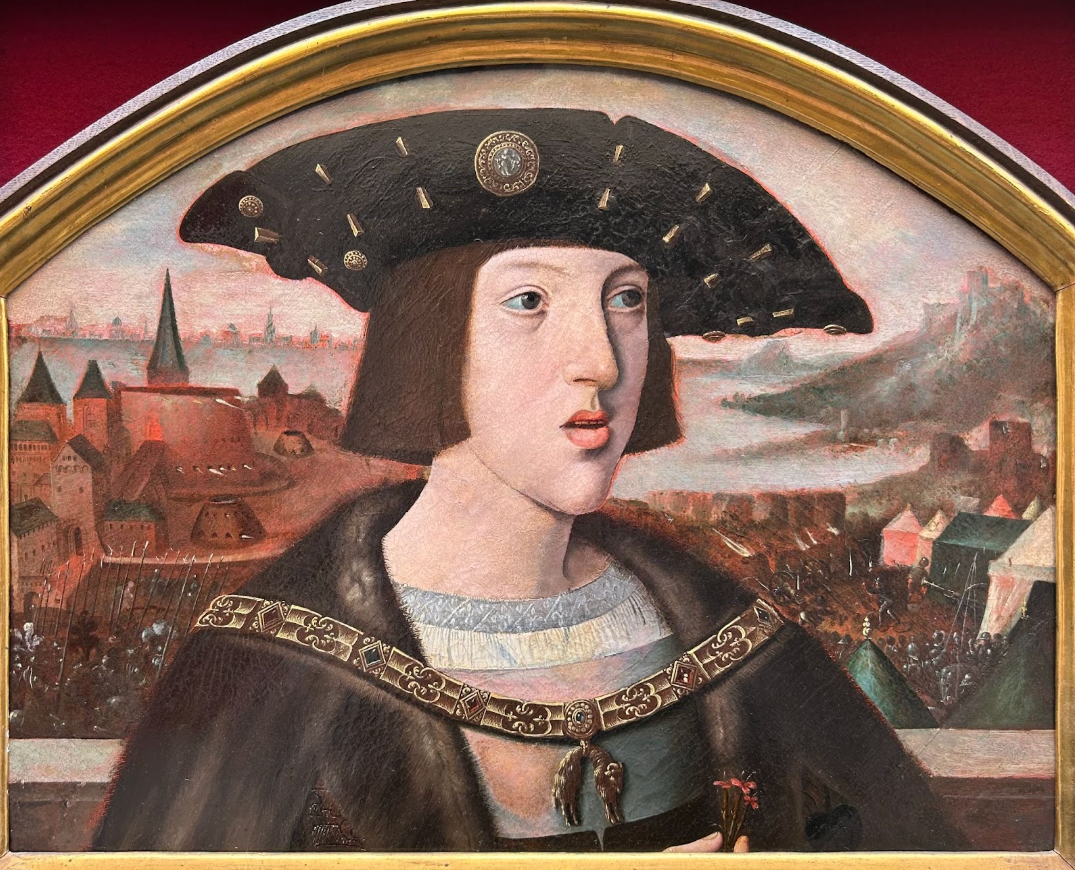
Circle of Hans Maler
Portrait of Charles V
Oil on panel
Image size: 18 2/3 x 14 1/5 inches (47.5 x 36 cm)
19th century display case frame
Provenance
C. Wilday - 12 Third Avenue, Harrow Road, W
1892: Christie's, sold in the collection of the late Hollingworth Magniac to Frederick Anthony White
1902: Exhibited at Burlington Fine Arts Club1907: The Toison d’Or (Golden Fleece) Exhibition, Bruges (British Committee), from the collection of Frederick Anthony White
1927: Exhibition of Flemish and Belgian Art at the Royal Academy London, from the collection of Frederick Anthony White
1934: Christies, sold to in the collection of the late Frederick Anthony White to Leggatt
At some point, it may well have been part of the collection of Sir James Stirling-Maxwell.
This painting depicts a young Charles V (1500-1558), before he became the Holy Roman Emperor. Around his neck hangs the chain of the Order of the Golden Fleece, a Catholic order of chivalry. In the background, soldiers can be seen engaging in fierce battle. According to a label on the back of the painting, the city visible in the background is Antwerp.
The artist is unknown, but the Royal Academy’s 1927 Exhibition of Flemish and Belgian Art attributed it to Jan Gossart (1472-1553). There are a number of similar paintings of both Charles V (Portrait by Bernard van Orley, c.1515, Louvre) and his younger brother Ferdinand I (Portrait by Hans Maler, c.1520, Kunsthistorisches Museum), which utilise the same unusual panel shape, similar background scenery, and similar facial features of the central subjects. It can be proposed, therefore, that the image dates from the early 16th century.
The painting has remained in private hands since 1890, featuring in the collection of merchant and medieval art connoisseur Hollingworth Magniac and that of concrete manufacturer and arts patron Frederick Anthony White.
Charles V
Charles V was born in Ghent on February 24th 1500, to Philip I and Joanna of Castile. His father was the son of the Holy Roman Emperor and Habsburg patriarch Maximillian I, and his mother was the daughter of the King and Queen of Spain, Ferdinand II and Isabella I. After the death of Philip I, the Netherlands came under the regency of Margaret of Austria, Charles’ paternal aunt who also assumed the duty of raising the young heir. During this period, he received spiritual guidance from Adrian of Utrecht, who later became Pope Adrian VI.
In 1515, Charles was old enough to assume rule over the Netherlands, becoming the Duke of Burgundy. The following year, 1516, Ferdinand II died and left the Spanish territories to his daughter Joanna. This resulted in a crisis of succession, as Joanna had been declared insane after the death of her husband and confined to the Royal Palace of Tordesillas. Charles became jure matris King of Spain, placing him in command of Castile, Aragorn, Spain’s colonies in the West Indies and Spanish Main, Naples, Sicily and Sardinia.
In 1519, Charles inherited the Habsburg territories in Austria and thus became the territory’s emperor-elect for the role of the Holy Roman Emperor. He was successfully elected, defeating the candidacies of Henry VIII of England and Francis I of France.
In 1521, Charles V drew up the Edict of Worms to decry Protestantism and the threat posed to Catholicism by Martin Luther’s Thesis. This would not be the last time religion would prove problematic for Charles V in his role as Holy Roman Empire.
Also posing a significant issue was the extent of Charles V’s territories, which rendered him in near-constant states of conflict with other nations. Francis I of France would become the nemesis of Charles V, with both kingdoms warring over the Italian territories. When Adrian of Utrecht became Pope in 1522, he tried unsuccessfully to reconcile the two monarchs - unfortunately, Pope Adrian died the following year, in 1523. The conflicts in Italy seemingly drew to a close at the Battle of Pavia (1525) when Charles V took Francis I as prisoner and forced him to agree to the Treaty of Madrid, which would have forced Francis I to relinquish his claim to Italy. Upon his release, Francis I rejected the treaty and refused to abide by its terms.
During the same period, the Ottoman Empire - under Suleyman the Magnificent - had begun to pose an increasing threat to Hungary and the Habsburg territories. After the death of Louis II of Hungary in the Battle of Mohacs in 1526, Charles V’s brother Ferdinand became the nation’s monarch, and the Turkish threat became one of the most pressing concerns facing the two Habsburg brothers. However, Charles V was preoccupied by the situation in western Europe, which was draining his resources and finances, leaving little to dedicate to curbing the Ottoman threat.
In 1527, Charles V directed his armies to attack Pope Clement VII, who had established the League of Cognac and allied himself against Charles V. In an act of mutiny against a lack of pay, Charles V’s armies sacked Rome in May. Pope Clement VII surrendered soon after.
In a surprising turn of events, the war between Francis I and Charles V was concluded in 1529 with the Treaty of Cambrai, devised between Louise of Savoy (mother of Francis I) and Margaret of Austria. Continuing this era of reconciliation, the Pope made peace with Charles V and crowned him Holy Roman Emperor in 1530, marking the last time the emperor would ever be crowned by a Pope.
Religious turmoil returned when Charles V attempted to find a way to ensure coexistence between Catholics and Protestants. Due to strong Catholic rejection of the Lutheran doctrine, Charles V turned his back on ensuring coexistence and reaffirmed the 1521 Edict of Worms. The Protestant nations turned against Charles V, who was forced to agree to concessions to ensure their armed support against the Ottomans, who managed to reach Vienna in 1532. Charles V soon departed Hungary, leaving its governance to Ferdinand, and began an unsuccessful campaign in North Africa to destabilise Suleyman’s position there.
Arriving in Naples, Charles V challenged Francis I to personal combat after he had invaded Savoy and Turin. When Francis I declined, Charles V invaded Provence, and Pope Paul III mediated peace through the 1538 Treaty of Nice.
This semblance of peace was soon shattered by uprisings in Ghent in 1539, which Charles V returned to the Netherlands to help quell. Charles V executed leading rebels, but granted Protestants major concessions (although they were later rejected by both the Pope and Martin Luther). Shortly after this, Ferdinand lost Vienna to Suleyman, prompting an unsuccessful naval venture near Algiers.
Despite financial difficulties, Charles V’s Spanish territories in the New World were expanding, with the addition of Mexico and Peru. Whilst the economic support from these countries did not amount to much during Charles V’s rule, it greatly aided his successors.
These poor finances were part of the reason that Charles V’s war with France - declared in 1542 after Charles V gave the duchy of Milan to his son Philip, angering Francis I - only consisted of two land battles. On the field of the third battle, the Peace of Crepy was reached instead of engaging in open hostility.
In 1545, Charles V was part of the Council of Trent, which sought to combat Protestantism and reaffirm Catholicism in Europe. The next year, Charles V went to war with the Protestant princes, eventually defeating them at Muhlberg in 1547. It was around this period that Charles V began to suffer with ill health.
North Germany was becoming restless, and the new King of France - Henry II - was eager to use this in order to enact revenge on Charles V for the Battle of Muhlberg. He signed a treaty that afforded him the cities of Metz, Toul and Verdun, with this expansion forcing Charles V to grant Protestantism the same rights as Catholicism. Charles V attempted to retake Metz, but failed, and surrendered to Henry II. This defeat marked the end of Charles V’s attempt at western European hegemony.
Desperately trying to preserve his legacy whilst struggling with ill health, Charles V married his son to Mary I of England. However, Parliament refused to crown him as King, and the marriage did not bear any children. After one last campaign against France ended in failure, Charles V abdicated and passed the Netherlands and Spain to Philip, and the imperial lands to Ferdinand. He spent his final years in a monastery in Yuste, Spain, where he worked to support his son procuring funds against France and his daughter to persecute Spanish heretics.
Charles V died in Yuste Monastery on September 21, 1558.

